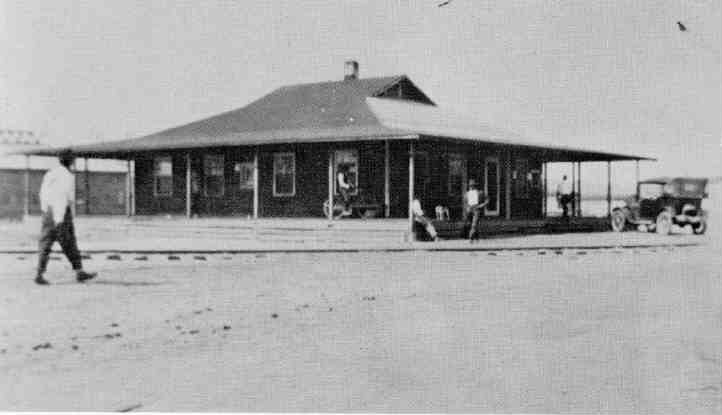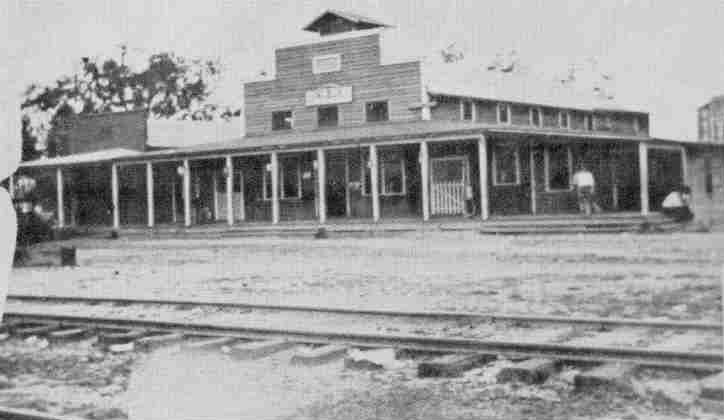
Carbur was said to be the world's largest log camp and well it may have been. Why Carbur and how did it receive its name? The story of that is intertwined with the great logging days that took place during the first three decades in this county. It all really started when Governor Bloxham sold large tracks of land for the school account and thus bailed out the system. Many rich men formed companies and one group was known as Carpenter-O'Brien, who's president was S. J. Carpenter. Their general office was located up north. The company bought thousands of acres of land in Dixie, Taylor, and Lafayette counties. Carbur was established about 1915 as a joint logging venture by the Carpenter-O'Brien Company (which Brooks-Scanlon acquired in 1917) and the Burton-Swartz Cypress Company, hence the name "Car-bur."

ACL Freight Depot at Carbur, Florida
The town was laid out on a 640-acre tract of land. The Carbur Logging Company supplied logs simultaneously for three of the largest lumber companies in the country: Carpenter-O'Brian, the Burton-Swartz Cypress Company and the Putnam Lumber Company.
The Carbur school started off as a one-room school with the first teacher a Miss Williams, according to several. Later it became a two-story building Mr. Alton Wentworth spent four years, from 1926 to 1930, as school principal at Carbur, where during that time the enrollment ran all the way from a low of two hundred and twenty-five on up to as high as three hundred. The Carbur, Senior High School was state accredited in 1927, for the next four years.
Mr. Wentworth occupied a four room company house which rented to the School Principal for eight dollars a month. Like all other houses, it had running water and electricity, but no sewage system. The toilets were all the outdoor, biffy type, with removable cans, but they were kept unusually clean. A special sanitary man looked after them daily, emptying the cans and putting some kind of disinfectant, which smelled pretty good, into them.
Carbur had some 1,000 homes for the employees, a doctor's office and clinic, a large commissary (or company general store), a hotel, boarding houses, railroad station and freight depot, a moving picture theater, schools up to and including the 12th grade for the black and white children of the employees and a large and much utilized machine shop for the maintenance of the logging equipment, including the companies' rolling stock in the form of steam driven rail road locomotives, skidders, loaders, and auxiliaries (railroad "flat" cars), and the myriad of tools and mechanical equipment required in the production of logs.
The black community had a church that was used alternately by the Methodist and the Baptists. This church was also used as the black school.
There were two churches Methodist and Holiness used for white worship. In those times much of the social life revolved around the church life.

Original Office

Carbur Mercantile Company
There was the hotel and near by the "Bullpen" where the bachelors lived. In addition to that, the huge Carbur Mercantile Company provided not only food and clothing and other vital necessities, but had a drug store of sorts or sundry as it would be called today. In addition to obtaining groceries from the mercantile store - nearby farmers would deliver produce, pork sausage, and other edibles, on Saturday. In fact the housewife had it a lot better in those days than now. Each morning, both the mercantile clerk and the clerk from R. F. Chesser's store in Winchester would come by to take orders and believe it or not these were delivered to the homes. Movies were shown on Saturday night.
In Winchester there was a garage to service the growing number of Tin Lizzies and other makes of cars that traveled the road connecting Carbur with Perry and points in other directions. Sometimes a group would get together and go by handcar into the woods as far as Dallas Creek to pick flowers and such. Although there were many horses, none of the girls rode but the boys did. Students from nearby communities came into Carbur for their schooling. A Mrs. Nelson came down from Perry to give piano lessons.
Further down the road, Alton Wentworth remembers, there were two other little settlements - - one was called White City and the other, Palmetto Heights, but down at the end of the old Dixie Highway was the town of Winchester -- and its life was closely tied in with Carbur -- in all activities.
The material for this article came from:
Buckeye Fiberscope --
March, 1975 -- by Louise Childers
Memoirs of an
Octogenarian -- by Samuel Gilbert Register
Carbur -- The Town That
Logs Built -- by Russell Tedder
Copyright © 1996 - The USGenWeb® Project, FLGenWeb, Taylor County